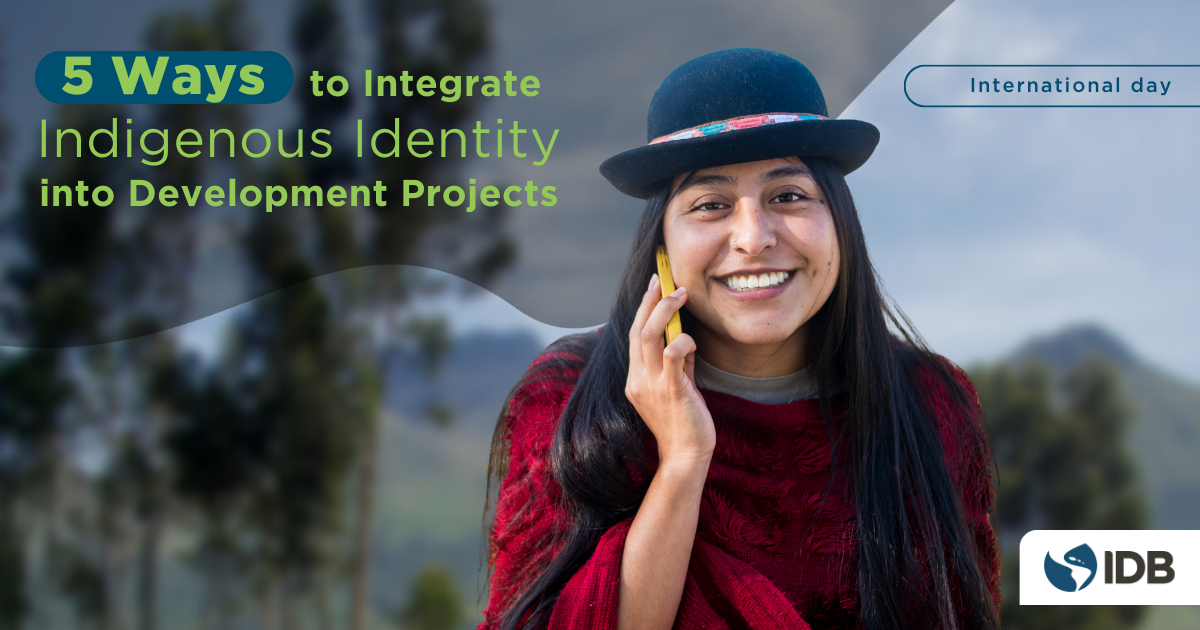“From there” – that’s what the first part of the word “Indigenous” means. The suffix “genus” means “born” or “originated.” In essence, this term, derived from Latin, means “originated from there.”
The origins, the “from there” of Indigenous Peoples in Latin America and the Caribbean, are diverse. There are more than 800 cultures present in the region. This “from there” factor is crucial to consider in development projects aimed at benefiting these peoples. Is this type of material “from there”? Are these the healthcare methods used there? What language do the indigenous populations speak there?
Currently, half of the Indigenous population lives in cities. The process of urbanization for these communities also means new “from there” elements to consider in project design.
How Do We Promote Development with Indigenous Identity?
At the IDB, our work with Indigenous Peoples employs the concept of “development with identity” as a framework. Development with identity is an approach that values the people and culture of indigenous communities as an essential part of their sustainable development. In other words, it integrates the “from there” aspects as a central part of a project and considers their perspective on well-being, governance, relationship with the land and natural resources, and cultural identity in the project’s design. This innovative approach allows us to bring forth solutions that encourage listening, respect, and inclusion.
These are just some of the ways in which we are integrating Indigenous identity into development projects:
1. Economic Development with Identity
One of the key areas of focus for the IDB is promoting access to quality formal employment, financing, and digital integration with and for Indigenous Peoples. The IDB supported the formal employment of 800 young Indigenous migrants in El Alto, Bolivia. The initiative promoted the enhancement of technical and intercultural skills among the youth and aided companies in implementing inclusive practices. In Panama, we involved Indigenous women leaders in policymaking to close the gender gap through the Panama Indigenous Women’s Economic Empowerment Program (PEMIP).
BID Invest launched a private debt fund with a focus on gender, diversity, and inclusion. This fund promotes, among other aspects, access to financing for micro, small, and medium-sized enterprises owned by Indigenous populations. On the other hand, through its BIOBuilders call, BID Lab provides funding to bioenterprises in the Amazon that strengthen the inclusion of Indigenous Peoples.
2. Infrastructure with Indigenous Identity
Another way we integrate Indigenous identity into our work is through infrastructure, employing an innovative approach known as ethnoengineering. This discipline incorporates traditional Indigenous knowledge as a source of inspiration for sustainable engineering practices. Based on ethnic identity and through participatory processes, infrastructure and services are developed to address local needs. The Ethnoengineering Guide published by the IDB outlines best practices and recommendations. The guide encompasses various sectors of infrastructure, from roads to education, health, social protection, and tourism. These principles were applied in Panama, specifically in the Ngäbe-Buglé region (comarca), where the IDB provided financing for the restoration of rural roads with an Indigenous identity. Local cultural elements were incorporated into the infrastructure, blending materials and functionalities from the local communities.
3. Culturally Relevant Healthcare
The integration of Indigenous Identity is also crucial in the realm of services. At the IDB, we promote cultural adaptations of healthcare services in terms of language, procedures, and beliefs.
For instance, during the COVID-19 crisis, the IDB published a Pictographic Community Guide for COVID-19 prevention in Indigenous communities, translated into multiple languages of our region. This guide supported the dissemination of crucial information through community media such as radio stations, social networks, and trusted authorities. In Guatemala, a program aimed at strengthening Indigenous people’s access to healthcare includes intercultural health training for public officials. It also involves adapting infrastructure to the needs of Indigenous communities. A similar approach is being implemented in the Gran Chaco region of Paraguay. There, 20 Family Health Units will offer primary care with cultural relevance. The installation process of these units involved Indigenous communities in decisions such as location, design, and available services.
4. Bilingual Intercultural Education
Bilingual Intercultural Education (BIE) is an example of how the education of Indigenous children and adolescents can be enhanced by integrating their cultural, ethnic, and linguistic heritage. In Panama, the JADENKÄ program supported bilingual intercultural education for 10,000 Ngäbe students. The initiative integrates both Spanish and the community’s native language, incorporating ethno-mathematics into teaching techniques. In Ecuador, a competition to recruit the best teachers for Indigenous schools, the “Quiero Ser Maestro Intercultural Bilingüe” (I Want to Be a Bilingual Intercultural Teacher), successfully filled over a thousand vacancies for this type of education. Other projects focusing on intercultural education were carried out in Bolivia, Brazil, Guatemala, and Peru.
5. Inclusive Climate Action
The IDB promotes and recognizes Indigenous Peoples as key agents in climate action and biodiversity conservation. Working with Indigenous and Afro-descendant communities as allies is a priority for the recently launched Amazon Regional Program: Amazonia Forever. This program aims to benefit communities in the Amazon region through sustainable and inclusive economic development models.
A Changing Reality for Indigenous Peoples
The “from there” aspects of Indigenous Peoples are changing. The pressures of assimilation and discrimination raise questions about the impact of urbanization on their identities. They also present new challenges and needs, such as food security, employment integration, and access to housing. It’s important to continue generating knowledge about the gaps affecting this population and implementing interventions that are not just for Indigenous Peoples but with them.


I guess I’m an indigenous person. I am an eighth generation Texan, and I still live here!
Now that our government has an entire day set apart for all of us indigenous persons, I really feel important!